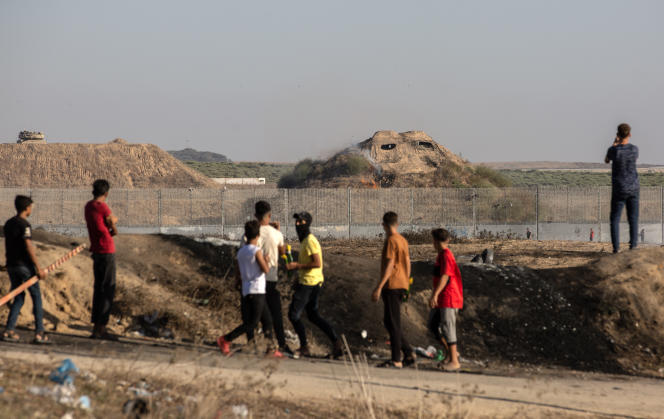The Jakar line stretches all along the Gaza Strip, three hundred meters from Israeli positions. In local slang, the name means to insist on being right. This is where around thirty demonstrators gathered this Tuesday, September 26, not far from an observation post, a few sheets of metal on a pile of earth, hastily rebuilt after having been destroyed by an air strike two days later. early.
In front of them, a dike, then around fifteen piles of tires ready to be set on fire. And, not far away, a gate topped with barbed wire and the fortifications of the Israeli army, mounds pierced with double openings, as if shapeless and immobile giants were monitoring the border.
Among all these young men, some masked, others not, Alaa Hicham, with his smile and his red polo shirt, gives the impression of having lost his way. “I see the Al-Aqsa mosque invaded by settlers, and the conditions of detention of Palestinian prisoners are getting tougher. I can’t stay at home and do nothing. So I come here to defend my land”, he said. At 21, he claims that he was already demonstrating in 2018, in the marches for the right of return, which punctuated life in Gaza every week for a year and a half before being stopped, Israeli bullets having killed more than two hundred people and injured some nine thousand, i.e. as many disabled people for life.
Assent of the Islamist organization
These mobilizations are different. Responding to the call of a new group, the Revolutionary Youth, they take place every day, at various points, such as here, in Malaka, to the north of the enclave, and all along the border. Israeli retaliatory fire left dozens injured and one dead. The gatherings are closely monitored by Hamas soldiers, who patrol in fatigues. This protest would be impossible without the consent of the Islamist organization, in this place normally closed to the public, but whose land was developed at the end of August with bulldozers.
Tension rose suddenly during this period, following the deaths of three Israeli civilians in three days in Palestinian attacks. At the end of the meeting of the Israeli security cabinet, Itamar Ben Gvir, the fiery minister of national security, called for a resumption of targeted assassinations. It was taken seriously: immediately, Hamas cadres disappeared into shelters, from the coastal enclave to the Palestinian camps in Lebanon.
You have 65.25% of this article left to read. The rest is reserved for subscribers.
